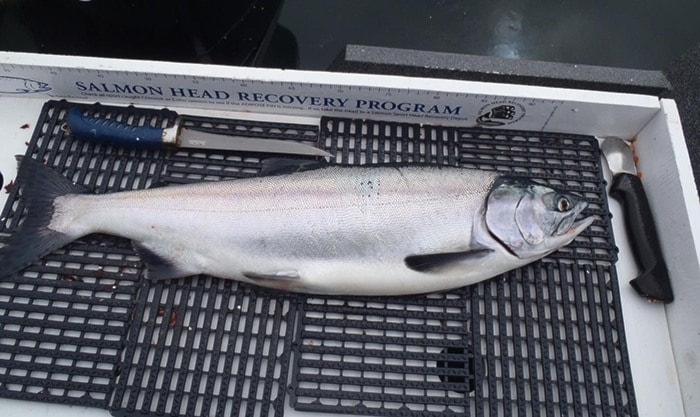Pink salmon are the smallest of our five species of Pacific Salmon we traditionally fish for throughout the season. One estimate of this year's Fraser River run is about 23,000,000 (yes, that is 23 million) pink and most of them will probably go past our waterfront as they migrate to the mouth of the Fraser River. There are also millions of pink returning to their mother streams and rivers in Strait of Georgia.
To be the smallest in a species of fish that is famous for its excitement and power as a fighting fish, is to be on the bottom of the salmon desirability chart if your goal is a large fish as in chinook, coho or chum salmon. On the other hand if you are humble enough to see this beautiful salmon as a magnificent species in its own right that provides great sport to all who fish them on light tackle. Their culinary qualities are the equal of any other species of salmon. You are now mentally tuned to enjoying pink salmon fishing in local marine waters for the next six weeks.
The 2015 season may go into the record books of the future as the year when the ocean produced millions of pink salmon and the home streams left them homeless to procreate their kind in dry river beds due to prolonged drought and water - too warm to survive in. Such may be the ecological tragedy facing the 2015 salmon runs.
Due to low water conditions, already existing in all the streams south of Campbell River with the exception of the Qualicums, are closed to all in stream angling. I am not running the show but if I was I would apply the same rules to the streams north of the Campbell unless there was solid evidence of adequate water sources feeding a river system with suitable temperature ranges.
So where does this leave a place for anglers to catch these abundant salmon arriving in our local waters on daily basis? Beach fishing is a well established method on hundreds of kilometres of beach fronts in Area 14 and elsewhere in the Strait of Georgia. Of all our popular chinook area, pink salmon will be so common they will considered a nuisance by those trying for other species.
When targeting pink salmon their name is a good clue in choice of colour of fly or lure. Generally typical sockeye hoochies or small pink spoons or jigs will work well. Casting form shore during a flood tide is a good time to catch them without the need of a boat.
When a school of fish is approaching you will learn to recognize the disturbance in the water. To be successful, just cast ahead of the school and time your lure retrieval so it passes through the school. Be prepared for an active strike and a good exchange on light tackle.
• • •
Between Family Fishing and the Comox Nautical Days the children of our Valley get to participate in two important children's fishing events. This weekend (Saturday, Aug. 1) the 29th annual Comox Nautical Days Bullhead Derby takes place in the Comox Harbour from 8:30 to 11:30 a.m.
This is no small event. Normally there will be about 500 small anglers aged from three to 12 years of age crawling all over the government wharf like a school of ants attracted to a source of special food. Little people will be assisted by anxious grandparents, parents and family friends in their efforts to catch a bullhead.
I advise filling out the registration form from the paper in advance of coming to the derby to save time. This column is proud of the Comox Valley Record's annual sponsoring of the weigh-in record keeping and holding pool for the fish prior to release.
Ralph Shaw is a master fly fisherman who was awarded the Order of Canada in 1984 for his conservation efforts. In 20 years of writing a column in the Comox Valley Record it has won several awards.
